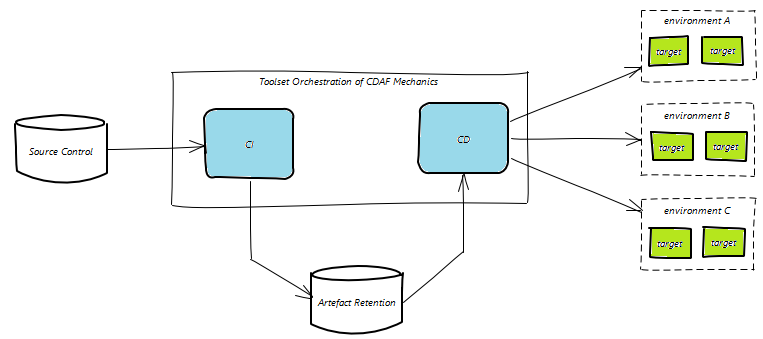CDAF
Continuous Delivery Automation Framework
Open Source Project authored over the last decade with the following key principles:
- Loose Coupling : Designed for workstation implementation first, with no tight coupling to any given automation tool-set
- Lowest Common Denominator : Using the minimum of the tool-chain plugins & capabilities, to ensure loose coupling
- Package Portability : Package Task execution designed for automated push / pull or manual deployment
- Task Definition : Framework to manage logging, exceptions and errors, to allow the user to focus on the tasks to be performed
CDAF, what it is, and what it is not
This documentation works through increasingly complex use cases. It is discouraged to open the CDAF code and try to determine it’s purpose from the code (although it’s open source, so you’re most welcome). The framework uses a significant amount of dependeny injection, and without an understanding of the purpose, the code will be quite difficult to follow.
| What CDAF isn’t | What CDAF is |
|---|---|
| The Continuous Delivery Automation Framework Does not give you DevOps | The Continuous Delivery Automation Framework is optionated to help you achieve DevOps principles for Continuous Delivery |
| CDAF is not a replacement of your CI/CD orchestration tool. | CDAF is loosely coupled, allowing you to test your automation before executing in your orchestration tool. |
| It does not replace your build tools, such as MSBuild, Maven, Ant, etc. | It provides a execution engine for your build tasks, to cater for logging, error and exception handling. |
| CDAF does not know how to deploy your application nor; does it know how to manage the configuration. |
CDAF provides delivery helpers for common deployment tasks. A tabular abstraction engine is provided to support tokenised configuration files |
Geared for Enterprise DevOps
The framework origin is within Enterprises, deploying production systems for internal and external consumption. Although CDAF is used for product shipping, i.e. the framework is used to deliver itself, this is not it’s primary purpose.
Framework Principles
CDAF provides consistency in the solution build, package and delivery mechanics, providing the basis of a code driven delivery, whereby any changes to the methodology are traceable in the source control system. While CDAF focusses on the mechanics of Continuous Delivery, the CI Tools are relied upon for source control integration, artefact retention and providing a graphical user interface for features such as reviewing automated test results and release gating.
Common Denominators
The following are core capabilities of CI/CD orchestration tools, which are factored into the CDAF design.
Git
Source Control in all the documentation is oriented to Git. There is nothing limiting the use of the framework with other source control system at all because it is loosely coupled, however, there are considerable additional features which work best with Git.
Build Artefacts
The results of the CI process can be retained and re-used in deployment process. This basic capability is critical to embrace the build-once/deploy-many principle.
Agents
CI/CD orchestration tools execute the task workload on Agents. There are a broad range of implementation styles, especially with regards to how the agents communicate with the server,and how tasks are distributed to agents, but the principle is largely the same.
some agents are obfuscated from the users, and others will execute tasks in isolated containers on the agent, which will be explored in more detail in the Containers section.
Pipelines
The capability of the CI/CD orchestration tools to decouple the CI and CD functions, with the CD operations being completely independent of source control.
Gating
As CDAF is geared toward enterprises, promotion to production is typically gated (Continuous Delivery) with Continuous Deployment being uncommon, therefore in this material, CD is a reference to Continuous Delivery unless otherwise stated.
